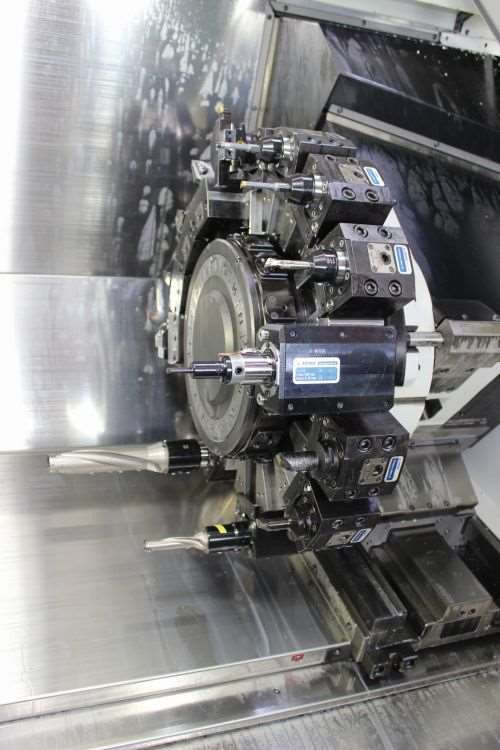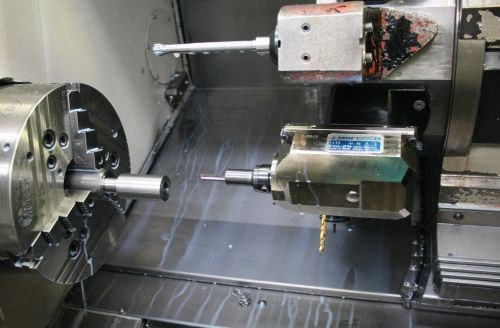Shaving Seconds with Faster Quick-Change Tool Systems
Modern tooling is reducing tool change time, taking tooling changes from minutes down to seconds.
Modern tooling is reducing tool change time, taking tooling changes from minutes down to seconds.
One of the critical measurements of machine shop productivity has always been equipment uptime, and in recent years, that factor has been dependent on improvements that amount to very few minutes or even seconds.
Featured Content
“One of the major factors behind our decision to incorporate the quick-change system is our goal of improving setup time,” explains Jimmy Lytle, president of Daystar Machining Technologies Inc. (Fletcher, N.C.), a job shop with CNC turning and milling centers. The shop focuses on precision machining and fabrication with quick turnaround for short-run, prototype and specialty part production. “Now our setup time has been reduced from minutes to seconds,” Mr. Lytle says.
Making quick tool changes and improving tooling life continues to be a priority among production machine shops as well as job shops everywhere. Not only is the saving of setup and change-over time increasingly valuable to them, but also important are the flexibility and stability of the quick-change system, as well as the potential for reduced capital investments in tooling.
‘Quick’ Gets Even Faster
Daystar recently installed the Solidfix system (by Benz Inc.)—a versatile, modular quick-change collet system that enables machine operators to perform setups and change-overs in speeds of 15 seconds or less—on two new lathes with live tooling, Y-axis capability.
“We have quick-change adapters on all the live tooling for those lathes,” Mr. Lytle says. “We can set the adapters out on the workbench and get everything ready for a setup. Then, we are in and out of the machine very quickly.”
The adapters to which Mr. Lytle refers are an advantage of the Solidfix quick-change system. Adapters are attached to individual tools and are quickly and easily inserted into a head via a bayonet-type mount that is then secured by turning a single nut using an Allen wrench. Various popular soft tools, such as live turrets, angle heads and static tools, can be interchanged with different size adapters. The system will fit older machining equipment as well as new models.
This modular quick-change system saves Daystar several minutes of time for each setup and also reduces its investment in tooling. Using the Solidfix system, the shop’s operators don’t have to remove the main tooling unit itself; they simply change the adapter, which holds the pre-measured tool. This also means that the shop doesn’t have to buy as many live tools, which are expensive by themselves. All they have to do is buy quick-change adapters.
“We are able to switch from a collet chuck to a shell mill adapter to a solid end-mill holder without having to change to a different live toolholder for every application,” Mr. Lytle explains. “Using this quick-change system, we have one somewhat expensive toolholder and everything else is fairly inexpensive, which gives us a great deal of versatility without a major capital investment.”
More ‘Plug and Playable’
In developing its new modular system, Benz took the original quick-change technology and simplified it. Instead of requiring operators to spin on and tighten tooling in the holder using a wrench, the new system requires only a simple turn of an Allen wrench.
Also, in a traditional quick-change system, the operator has to remove the tool, install a new tool, then touch-off their tool to ensure the offset is correct. With the Solidfix, they can preset tools on a granite surface plate. When their tool starts wearing or another type is required, they simply insert and secure the new tool.
“Essentially, they’re putting the whole tool aggregate back in, and the repeatability is so accurate, they can program in what they just measured off their height gage so they don’t have to go through that scenario of touching off the tool, and then programming the offset,” explains Mike Starnes, Benz sales application engineer. “So, Solidfix is really a plug-and-play system. Operators just switch out the soft tooling, and they’re all set.”
An Added Safety Measure
“When operators try to work quickly on a traditional setup, they can be exposed to injury,” Mr. Starnes explains. “Normally, the cutting tool they are removing is very sharp. Even if it’s too dull to accurately machine a part, it’s still very sharp to the human skin. If the operator gets cut while handling one of those tools, the wound could be deep enough to require stitches. So, even highly experienced operators have to be very careful when handling cutting tools. When these mishaps occur, they have to go to the nursing station and at least get the wound cleaned up. In more serious cases, they may have to go offsite to a doctor or hospital. When such injuries occur, even more production time may be lost.”
Mr. Starnes adds that with the Solidfix system, operators are performing a much simpler task, which in most cases can be performed using one hand. Because of the ease of mounting and securing the adapter and tooling, exposure to potential injuries—and loss of operator time—is minimized.
When this shop took into consideration the simplified process of the new quick-change tooling and the decrease in setup time, there was no question whether they made the right decision to implement this tool into its processes.
RELATED CONTENT
-
Selecting the Right Milling Tool for Any Machining Task
High-performance milling cutters combine high cutting data with long tool life and efficiency, but certain factors must be considered when selecting tools for different machining tasks.
-
Plateau Honing Improves Finish and Lubrication Control
Plateau honing is a process that improves cylinder wall surface finish by removing tiny peaks of torn or folded material and increasing bearing area.
-
Cutting Tool Coating Production
This article looks at the coating methods available for carbide cutting tools.








